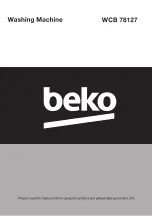
FLEX LS | USER MANUAL | 9
1.1.1. PLACEMENT
The FLEX LS may be placed in a vending bank or next to single vending machines. The narrow width
conserves space, and its height matches that of vending machines.
1.1.2. USAGE
By design, the FLEX LS and FLEX LS Tri are easy to use. The LCD screen provides instructions and recycling
information to the user. The machine’s sponsor can request custom messaging on the LCD.
When a user approaches the machine with a used PET, aluminium, or steel beverage container:
1. The user places the container into the feed unit bar code up.
2. The conveyor moves the container into the machine.
3. As the container passes under the scanners, the scanners read the bar code.
4. While moving along the conveyor belt, the PET sensor determines if the container is PET plastic,
and the metal sensor determines if the container is an aluminium or steel can.
5. If the RVM rejects the container, the conveyor reverses to return the container back to the user. It
displays a message instructing the user to remove the container. The message also tells the user why
the container was rejected. The following are reasons for rejection:
• The materials sensors do not detect a steel or aluminium can or a PET plastic bottle.
• The bar code is readable but not in the RVMs database of acceptable containers.
• The scanner cannot read the bar code, because the container is damaged, missing a bar
code, or the bar code is not facing upwards.
6. If the container is acceptable, the conveyor moves the container into the sorting cylinder,
which turns to push the container into the compactor.
7. The compactor runs; the container is crushed.
8. The crushed container falls into the bin below.
9. The RVM gives credit to the user for the container.
1.1.3. SERVICE INTERRUPTIONS
If the FLEX LS malfunctions while servicing a customer and money is due to the customer, the FLEX LS
automatically pays the customer before going out of service. In the case of a power outage, the machine
retains the amount due to the customer. When the machine turns on, the customer can push the “request
payment” button to receive payment. The software prevents double payment if there is a machine
malfunction or machine shutdown. In the case of a printer malfunction, the amount due to the customer
will remain on the LCD until the printer problem is fixed and a receipt is printed.










































